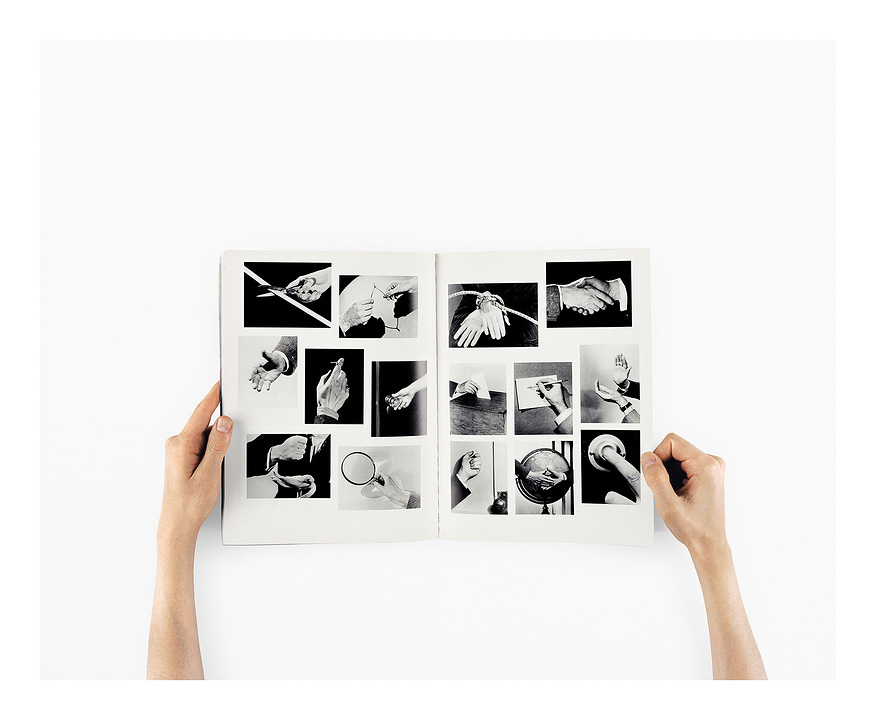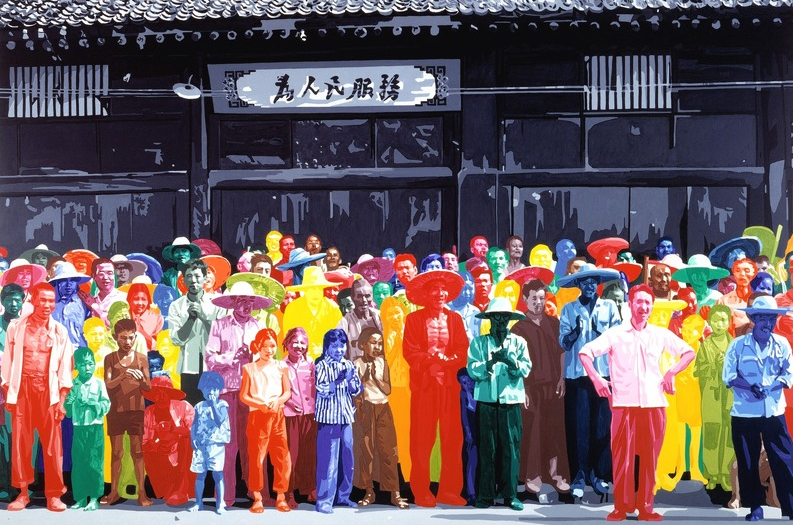February 2016 (original) (raw)
In the 1920s, golden years before life became data, a young H. Armstrong Roberts was ensconced in the movie studios of Edison, New Jersey, trying to make it as a scriptwriter. He watched how the studios choreographed shoots, and he noticed something: with the right staging, you could produce a whole variety of images that could be sold to clients without the skills or the disposition to shoot their own. RobertStock, the agency he soon founded (still in business!), hired models, lighting technicians, and makeup artists to craft vacuous pictures of arranged situations: a woman brushing her teeth, a stick of butter in a porcelain dish, a grinning white family with a gleaming new car. The images could say whatever you needed them to say. Most frequently, they said Buy.

Anne Collier. Stock Photography (Gestures). 2013. Courtesy the artist; Anton Kern Gallery, New York; Marc Foxx Gallery, Los Angeles; Corvi-Mora, London; and The Modern Institute, Glasgow.
Ordinary Pictures
Walker Art Center, Minneapolis
Opens February 27
In the 1920s, golden years before life became data, a young H. Armstrong Roberts was ensconced in the movie studios of Edison, New Jersey, trying to make it as a scriptwriter. He watched how the studios choreographed shoots, and he noticed something: with the right staging, you could produce a whole variety of images that could be sold to clients without the skills or the disposition to shoot their own. RobertStock, the agency he soon founded (still in business!), hired models, lighting technicians, and makeup artists to craft vacuous pictures of arranged situations: a woman brushing her teeth, a stick of butter in a porcelain dish, a grinning white family with a gleaming new car. The images could say whatever you needed them to say. Most frequently, they said Buy.
Stock photography, which really began to flourish in the 1980s and now overgrows the web like kudzu, operates from the premise that a client will sacrifice creative control (and uniqueness) if the cost of buying others’ photographs drops significantly lower than hiring your own man for the job. It has fallen more than anyone could have foreseen. Many online agencies will now sell you shock shots of smiling corporate drones—a bit more racially diverse than in the old days, though no less zombified—for just a dollar. Yet while the value of any single image has cratered, the stock photography industry is thriving; control the archive and its metadata, and you have something much more valuable than pretty pictures. Getty Images was sold for $3.3 billion a few years back, and Adobe now soups up Photoshop with a database of 40 million stock images, of hot air balloons and fluffy clouds, sold on subscription to impatient copyists. You will not be surprised to hear Adobe claims the 40 million photographs are “curated.”
For a certain sort of less thoughtful, digitally addled young artist—we’re not naming names this time, but there are whole gallery rosters that deserve the epithet—the vacuity of stock photography is an easy shorthand for a world out of whack. It would be a real pity if that blithe nihilism took hold more widely, and the stock photograph became nothing more than a setup for Tumblr punchlines. Hence the promise of “Ordinary Pictures,” curated by the Walker’s Eric Crosby, which promises to reexamine the pervasiveness of the stock-photography aesthetic in contemporary art by pushing back well before the digital era, all the way to Pop and experimental cinema. The films of Owen Land, for example, edited schlocky advertising campaigns into nearly metaphysical revisions, while Sherrie Levine and John Divola took very different but complementary routes into photographic artifice. More than anything, though, we’re dying to rediscover Steve McQueen’s Once Upon a Time (2002), composed of 116 stock images NASA blasted into space: the United Nations at sunset, a dew-flecked leaf, and giggling schoolchildren. It’s a sobering thought that aliens might first know us through our stock photography, though given the planetary realities those image belie, we might be putting our best foot forward.

Anri Sala. Long Sorrow. 2005. Super 16mm film transferred to video, sound, color. 13 min. Courtesy Marian Goodman Gallery, New York; Hauser & Wirth; Galerie Chantal Crousel, Paris; Galerie Rüdiger Schöttle, Munich; and Johnen Galerie, Berlin.
Anri Sala
New Museum, New York
Opens February 3
Early in his career Sala used video to conjure the distress and uncertain future of post-Wall Europe; one indelible work, peskily not included in this show, features the artist’s mother at a communist rally, but the sound, and the meaning, are lost. (The narrator of another video, the 2001 Tirana travelogue Dammi i Colori, is now prime minister of Albania.) Now in Berlin, Sala has been engaged lately with the power of music, as an elegy for progress and a salve for history. We're devoting a big chunk of Even no. 3 to Sala; the new issue is out shortly.
Peter Wächtler
Renaissance Society, Chicago
Opens February 7
This is the first stateside solo for the German-born, Brussels-based Wächtler, who loathed art school but loved writing. The prodigious wordsmith’s narratives of quotidian failure are the starting point for films, drawings, ceramics, and sculptures whose communicative gaps are both sincerely comical and comically sincere.
Andrés Jaque/Office for Political Innovation: Superpowers of Ten
Fundación Jumex, Mexico City
Opens February 11
We flash back to middle-school science class and to Powers of Ten, Charles and Ray Eames's educational classic, in which the camera's exponentially accelerating zoom shows us the universe's bewildering expanse (and our own puniness). Jaque adds to the Eameses's original a performance, a conference, a workshop, and a dazzling array of objects: an extended cut of sorts.
Daniele Genadry
Sursock Museum, Beirut
Opens February 12
This young Lebanese-American artist made a strong New York debut earlier in the season, and she gets another outing at the ornate Sursock villa, which reopened last fall after a seven-year renovation. Genadry's spare, stonewashed paintings and drawings make use of unlikely scale and off-center viewpoints; migration, in her work, becomes a kind of abstraction.
Gérard Fromanger. En Chine, à Hu-Xian. 1974. From the series "Desire Is Everywhere." Courtesy Centre Georges Pompidou, Paris.
Gérard Fromanger
Centre Georges Pompidou, Paris
Opens February 17
Tate Modern’s recent show “The World Goes Pop” was the most recent attempt to revive the status of narrative figuration, the most stridently leftist, and least loved, recent movement in postwar French art. The hot-colored compositions of Fromanger, a collaborator of Godard’s and a favorite of Foucault’s, get another airing here; you can decide whether he was rebooting history painting or just carrying water for the Cultural Revolution.
The Soul of Money
DOX Centre for Contemporary Art, Prague
Opens February 19
The root of all happiness, John Banville once wrote. Jenny Holzer, Alfredo Jaar, and the anonymous Polish collective The Krasnals all appear in this aspirant exhibition on art’s place in the neoliberal settlement, and the possibility of aesthetic judgment when the only marker of value is price.
Maniera
Städel, Frankfurt
Opens February 24
We here at Even are die-hard advocates of the torqueing figures and elongated necks of mannerism—the first style in western painting that estimated an artist’s intellect higher than his sight or skill. This major show, with 120 works by Bronzino, Pontormo, and other Florentine all-stars, situates mannerism in a roiling 16th-century Italy whose painting-besotted aristocrats liked their pictures refined and perverse at once.
